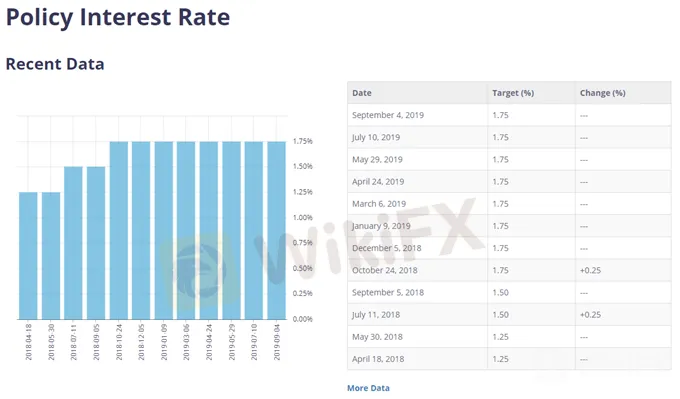简体中文
繁體中文
English
Pусский
日本語
ภาษาไทย
Tiếng Việt
Bahasa Indonesia
Español
हिन्दी
Filippiiniläinen
Français
Deutsch
Português
Türkçe
한국어
العربية
USDCAD Forecast: RSI Snaps Bullish Formation Following BoC Meeting
Abstract:Recent developments in the Relative Strength Index (RSI) foreshadow a further decline in USDCAD as the indicator snaps the bullish formation carried over from July.
Canadian Dollar Talking Points
USDCAD trades to fresh monthly lows following the Bank of Canada (BoC) meeting, and recent developments in the Relative Strength Index (RSI) foreshadow a further decline in the exchange rate as the indicator snaps the bullish formation carried over from July.
USDCAD Forecast: RSI Snaps Bullish Formation Following BoC Meeting
USDCAD may struggle to retain the advance from the 2019-low (1.3016) as the BoC sticks to a wait-and-see approach, and it seems as though the central bank will keep the benchmark interest rate on hold throughout the remainder of the year as “the current degree of monetary policy stimulus remains appropriate.”

The BoC appears to be in no rush to alter the forward guidance for monetary policy as “growth in the second quarter was strong and exceeded the Bank‘s July expectation,” and Governor Stephen Poloz and Co. may stick to the same script at the next meeting on October 30 as “Canada’s economy is operating close to potential.”
In contrast, the Federal Reserve appears to be on a preset course to reverse the four rate hikes from 2018 as St. Louis Fed President James Bullard, a 2019-voting member on the Federal Open Market Committee (FOMC), insists that the central bank “should have a robust debate about moving 50 basis points” at its quarterly meeting scheduled for September 18.
With that said, it remains to be seen if the fresh updates to the US Non-Farm Payrolls (NFP) will impact the monetary policy outlook even though the economy is anticipated to add another 160K jobs in August as Fed Fund futures continue to reflect overwhelming expectations for a 25bp reduction later this month.
In turn, the Canadian Dollar may outperform its US counterpart amid speculation for back-to-back Fed rate cuts, and the diverging paths for monetary policy may spur a broader shift in USDCAD behavior as the exchange rate snaps the upward trend carried over from the previous year.
Sign up and join DailyFX Currency Strategist David Song LIVE for an opportunity to discuss potential trade setups.
USD/CAD Rate Daily Chart

Source: Trading View
Keep in mind, the broader outlook for USDCAD is no longer constructive as the exchange rate clears the February-low (1.3068), with the break of trendline support fostering a bearish outlook for Dollar Loonie.
At the same time, the rebound from the 2019-low (1.3016) appears to have stalled ahead of the Fibonacci overlap around 1.3410 (38.2% expansion) to 1.3420 (78.6% retracement), with the exchange rate at risk of extending the recent series of lower highs and lows as the Relative Strength Index (RSI) snaps the bullish formation from July.
The break/close below 1.3220 (50% retracement) brings the 1.3120 (61.8% retracement) to 1.3130 (61.0% retracement) region on the radar, with the next area of interest coming in around 1.3030 (50% expansion).
Disclaimer:
The views in this article only represent the author's personal views, and do not constitute investment advice on this platform. This platform does not guarantee the accuracy, completeness and timeliness of the information in the article, and will not be liable for any loss caused by the use of or reliance on the information in the article.
Read more

Dollar stands tall as Fed heads toward taper
The dollar held within striking distance of the year's peaks on the euro and yen on Wednesday, as investors looked for the Federal Reserve to begin unwinding pandemic-era policy support faster than central banks in Europe and Japan.

Gold Price, Silver Price Jump After Saudi Arabia Oil Field Attacks
Gold and silver turned sharply higher after the weekend‘s drone attacks on Saudi oil fields saw tensions in the area ratchet higher with US President Donald Trump warning Iran that he is ’locked and loaded.

FX Week Ahead - Top 5 Events: August Canada Inflation Report & USD/CAD Rate Forecast
The August Canada inflation report (consumer price index) is due on Wednesday, September 18 at 12:30 GMT.

EURUSD Fails to Test 2019 Low, RSI Flashes Bullish Signal After ECB
EURUSD fails to test the 2019-low (1.0926) following the ECB meeting, with the Relative Strength Index (RSI) breaking out of the bearish formation carried over from June.
WikiFX Broker
Latest News
Forex Market Outlook: Key Currency Pairs and Trading Strategies for March 24–28, 2025
Singapore Police Crack Down on Scams: $1.9M Seized, 25 Arrested
Gold Prices Swing Near Record Highs
XTB Opens New Dubai Office
Africa Cybercrime Bust: Over 300 Arrested in Fraud Crackdown
The Growing Threat of Fake Emails and Phishing Scams
Hong Kong Banks and Authorities Collaborate to Freeze Fraudulent Accounts Faster
SocialFi and the Forex Market: A New Era for Decentralized Social Trading?
Is Billion Bucks Fx Scam?
BaFin Halts USDe Token Issuance, Citing Serious Compliance Failures
Currency Calculator







